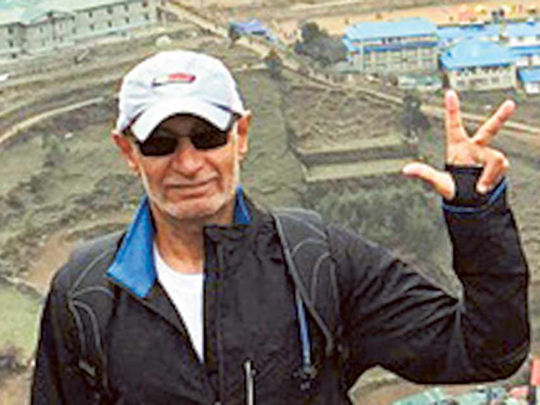
I was at 3,400 metres above sea level just 20 minutes away the Sherpa town of Namche deep in the Himalayas when the massive 7.9 earthquake hit Nepal two weeks ago.
It was around noon time when I along with a group of four experienced trekkers, two from the US, one from Britain and a professional Nepalese mountain guide were attempting a 12-day climb to the 5,300-metre high Everest Base Camp. Nearly 37,000 trekkers of different ages and diverse nationalities try to ascend the rough Himalayas every year.
Mountain trekking is my hobby. I have already made it to the 5,892-metre-high Kilimanjaro, the 4,300m-high Alps Mountain trails and the 3,660m-high Mount Fuji in Japan and many other mountains in between. Beside a few necessary bruises and scratches I have never been in an extremely risky situation. This year’s Himalayas trip stands as the worst experience yet.
It all started on the third day of trekking at around 11:45am. That Saturday, April 25, the ground started shaking violently and the formidable looking Himalayan mountains with their imposing 8,850-metre-high Everest summit was suddenly not as formidable as it looked.
The mountains beneath and around us were literally shaken to their foundations by the earthquake with its epicentre west of Katmandu. It only lasted for 45 seconds but was enough to cause nearly 10,000 deaths throughout Nepal and scare adventure trekkers away from the Everest Base Camp for the second year in a row.
One minute later there was this very loud deep rumbling noise that sounded like thunder as it was a cloudy and rainy day. The noise got deeper and louder and lasted for a fraction of a minute but was enough to frighten us to death. We were at a loss looking for safety but nowhere was safe in Nepal that day.
Then a complete and uneasy silence engulfed the entire Himalayas. Mount Everest was back standing tall but probably not as formidable as it once was. To survive such a moment at a remote place where things were falling apart was fortunate. The quake did not stop. There were more aftershocks with terrifying landslides in the distance. In total there were some 20 aftershocks that had everyone running helter skelter in a hotel and a nearby potato field in freezing, rainy weather.
The third day in Namche was the worst. Besides the continuing cold weather and seismic activities, the long wait for the promised rescue helicopter was mentally exhausting.
The way to survive the extremely risky situation was not easy, but the first lesson when the going is tough is to never give up. The second lesson is no matter how challenging the situation, start counting your blessings.
In my case I was lucky to survive the initial quake and the earth slide. I was fortunate to be with a supportive group. Every single day I was also surrounded by a welcoming and caring Sherpa family. Equally important, the hotel provided warm accommodation, decent food, plenty of drinkable water, 24-hour electricity, all were luxury items at the time. Above all there was the uninterrupted and cheap internet connection. There were no phone services but I was fortunate to live in the comfort of the virtual world when the real word was in a big mess.
There was no need to despair when hundreds of people on Twitter swiftly formed WhatsApp group called ‘Friends of Abdulkhaleq’ and provided badly needed emotional support. But the biggest blessing on the list was knowing that the UAE government was doing everything feasible to see to my safe return home.
I was also proud to know that the UAE was among the first 5 countries to send urgently needed help to Nepal. The state of the art Dubai International Humanitarian City offered unprecedented assistance to the survivors despite the innumerable challenges at the choked Kathmandu airport.
For my last day in Nepal I was with the UAE Red Crescent team that was desperately searching for adequate warehouses to accommodate 1,200 tonnes of aids due to arrive from the UAE. During the devastating earthquake, nine UAE citizens were trapped in Nepal. The UAE government secured the safe return of 5 citizens immediately. Three others were evacuated in the next 48 hours. It is amazing to see the extent to which the UAE cares for its citizens in disaster areas.
However my case was the most difficult. I was stuck in Namche, deep in the Himalayas. Because of the state of emergency, bad weather and pure bad luck all attempts to secure a helicopter ride to Kathmandu failed. I waited for the helicopter ride that never came. This was the most miserable part of the whole trip. The team I was with had no choice but to leave Namche and walk for nearly 7 hours to Lukla. We made the two-day walk in one day.
From the congested Lukla airport which is listed as one of the world’s most dangerous airport, it was relatively easy to take the turbine engine plane to Kathmandu and then fly to Dubai. I was the last Emirati citizen to leave traumatised Nepal.
Living through extreme risks was truly an experience of a lifetime. The 14-day trek to the Everest Base Camp was not supposed to end this way. However I feel grateful I am safely home and back at work but I am sad for the shattered country I left behind. My heart still aches for the friendly people of Nepal.
Dr Abdulkhaleq Abdulla is professor of Political Science. You can follow him on Twitter at www.twitter.com/Abdulkhaleq_UAE








